Protective Horseback Riding Vest Guide
Updated December 8, 2022
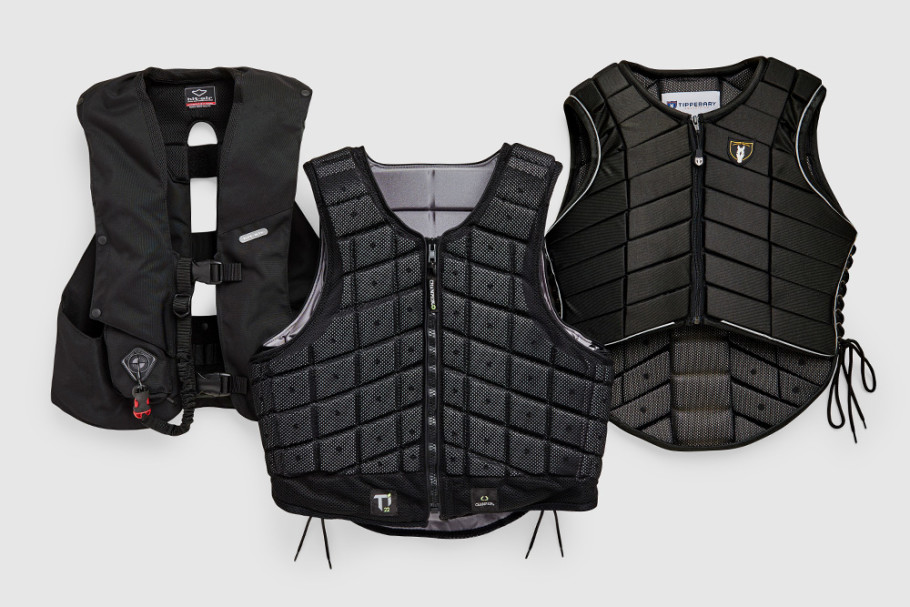
Which Safety Vest is Right for Me?
Have you ever wondered if you should be wearing a protective riding vest, or stared at all the different types, styles, colors, and brands of safety vests and wondered how to choose the right one? We’ve done the heavy lifting to help you make an informed choice when shopping for a protective riding vest to best suit your riding style and wallet!
History of Riding Safety Vests
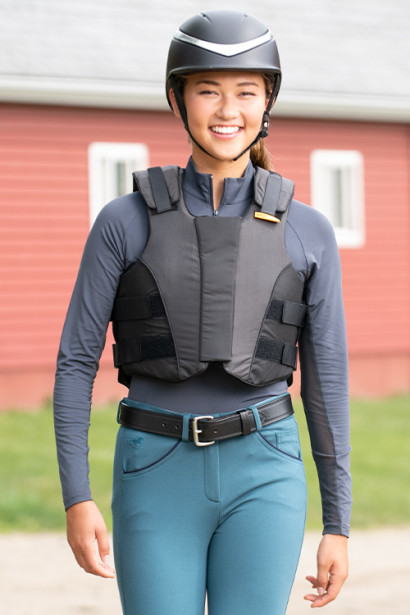
Protective vests started being used in the 1980’s and 90’s for multiple sports. Event riders, steeplechase jockeys and rodeo riders all embraced the opportunity for additional safety. The earliest vests looked like lifejackets, but technology has changed the form and function over the last few decades, as well as who uses protective vests.
Jockeys and exercise riders wear vests on the track, and rodeo riders wear them to ride bucking broncs and bulls. In some countries, beginner riders wear them for lessons. Around the world, vests are mandatory for eventing riders in recognized competitions during the cross-country phase.
Safety Testing of Protective Vests
Similar to riding helmets, there are safety testing standards set by organizations such as ASTM (American Society for Testing and Materials), BETA (British Equestrian Trade Association) and SEI (Safety Equipment Institute). Vests are considered certified protective vests by an organization after passing safety testing, although not all protective riding vests are certified.

More and more riders are choosing to wear vests for everyday riding – for trail riding, in the hunt field, schooling and showing on the flat and over fences in the ring, as well as more traditional use while galloping and cross-country jumping.
Types of Protective Riding Vests
There are two main categories of protective vests:
- General or Passive Vests - made of shock-absorbing materials.
- Air Vests - require deployment of an air canister that rapidly inflates the vest to provide protection.
General or Passive Riding Vests

Passive vests can be approved or non-approved. Approved passive vests tend to be slightly heavier, with dense foam overlapped to prevent open seams and decrease the likelihood of impalement injuries. They can be a bit bulky, but most are made of materials that mold to the body, especially in warmer weather, so they become more comfortable with use. Non-approved passive vests tend to be lighter, with seams around foam blocks that allow for greater flexibility and comfort, but the level of protection is lower.
Safety Air Vests

Air vests are lightweight shells with a compressed air cartridge attached to them. These vests must be tethered to the front of the saddle with a provided cord so that the inflatable panels deploy only when the rider becomes separated forcefully from the horse. During a rider fall, the cord will pull the trigger from the vest, deploying the air cartridge and inflating the air vest in a blink of the eye.
Due to the need for activation, there are circumstances when air vests will not deploy, such as the horse and rider falling together and not separating far enough to deploy the vest. Due to this, rules in eventing state that riders must wear a passive vest underneath an air vest. Several manufacturers have combo vests that combine an approved passive vest with an air vest in one unit.
How to Choose the Right Protective Riding Vest
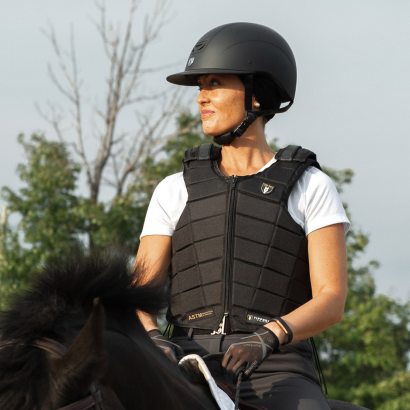
So, which vest should you choose? That depends on what level of protection you are looking for, what comfort level you would like, and how much you are willing to spend.
Vests with the highest level of protection can be the bulkiest to ride in, and therefore may not be as suitable for everyday schooling. However, you should always keep safety your priority. Know that the risks associated with riding at speed, whether it’s over fences, across varied terrain, or around barrels can make it crucial to wear maximum protection.
You’ll see riders of all disciplines in different types of vests, though you’ll commonly see eventers riding cross-country in approved vests with integrated or separate and layered air vests. While casual riders may use a lighter-weight unapproved vest every time they ride. If you’re not sure about which type is right for you, be sure to evaluate the possible options with your trainer.
Ask a Trainer Video – Protective Vests with Eventer Boyd Martin
In this episode of Ask a Trainer, Olympian and Pan American Games Gold Medalist, Boyd Martin shares his thoughts on protective vests, which one he uses, and why.
Riding Vest Care and Maintenance
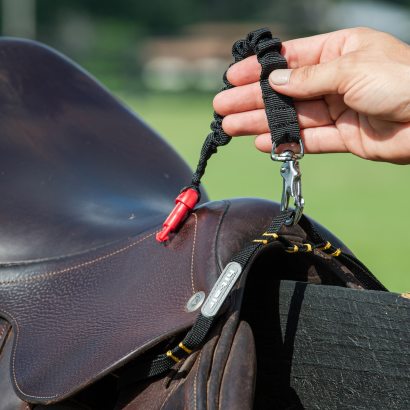
Protective riding vests can deteriorate over time due to dirt, wear and tear, and impacts that affect the absorption of shock. To ensure longevity of protective vests, it is important to maintain their cleanliness and shape, and check them regularly for damage.
For inflatable air vests, most manufacturers recommend sending them back for annual inspection to ensure the air bladders are intact and the mechanisms are working properly. For traditional protective vests, this includes following the care instructions and checking seams and straps for integrity. Some vests have an outer layer that can be machine or hand-washed once the protective padding is removed, while others are integrated and need to be spot-cleaned.
It is important to keep your vest hanging on a wide shaped hanger that provides more support than a wire hanger to prevent the protective material from folding or molding around the thin wire. Many protective vests are made with memory foam, which can mold into uncomfortable shapes if not hung correctly, and they can become very stiff and rigid in cold weather.
When Do I Need to Replace My Safety Vest?
Protective materials can deteriorate over time, especially if left in direct sunlight and exposed to water, dirt and sweat, so replacing protective gear a minimum of every five years is a general rule of thumb. As protection equipment is constantly evolving thanks to technology and research, this allows you to keep up to date with the most effective protection. If you’ve fallen off and your air vest inflated, you’ll need to replace the vest’s air cartridge.
How to Know if Your Protective Riding Vest Fits
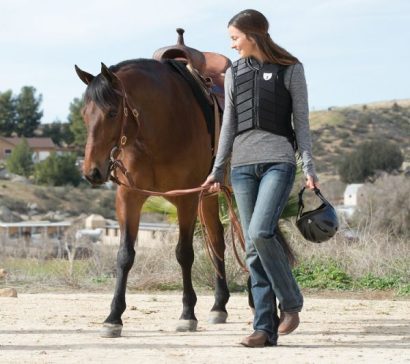
Once your new vest arrives, follow these steps to see if it fits:
- When you unpack your vest, save the packaging in case you have to return it, and leave the tags attached.
- Make sure you’re wearing something similar to what you would wear when you’ll be riding with your vest on.
- Loosen any straps or cords on the sides of the vest, then put it on and zip or clip the closures.
- Adjust any fitting straps or cords so the vest is snug without being tight – you shouldn’t feel like you are wearing a straitjacket! On the flip side, passive vests should move with you, so it shouldn’t be loose as you move around.
If you can’t get it closed or if it’s too big, try the next size up or down. If it seems to fit well, try sitting in a chair or in a saddle – does the back of the vest hit the chair or cantle of the saddle? If it shifts the vest up, the vest may be too long. You should be able to fit a few fingers between the bottom of the vest and the saddle, although this is less important for casual riding than it is for cross-country jumping, where you may need to lean back when jumping down banks.
If the vest seems very stiff when you first put it on, give it some time to warm up and mold to your body – walk around, sit on the couch, move around a bit to see if it will start to break in and move with you. For air vests, make sure you try them on over a passive vest if you plan to do so. These vests need to be slightly loose, so make sure you can fit a closed fist between the air vest and your body or the passive vest you plan to wear with it.
Don’t be discouraged if you don’t get the right size the first time. Protective riding vest fitting can be a bit of trial and error. SmartPak has you covered though with free shipping on all orders over $75 and free return shipping on all sized items. It’s easy to order another to try if the first vest style doesn’t quite fit.
Shop All Protective Riding Vests
Originally published March 28, 2018.